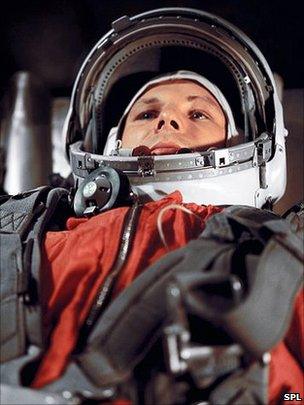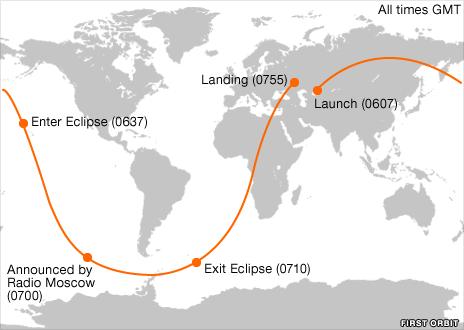Profile: Yuri Gagarin
- Published

Gagarin's name was immortalised when he made a single orbit of Earth in 1961
On 12 April 1961, manned space travel escaped the pages of fanciful fiction and arrived blazing into the here-and-now.
The first space flight was a triumph for the Soviet Union and a political and diplomatic setback for the US.
But Yuri Gagarin was an instant history-maker whose achievement transcended the politics of the time.
He was born in the village of Klushino, outside Moscow; his father was a carpenter, while his mother worked as a milkmaid. His family, like many others, had suffered at the hands of the Nazis in World War II.
During the German occupation, the Gagarins were forced out of their home and had to live in a tiny "mud hut" nearby. Yuri's brother Valentin and his sister Zoya were deported to labour camps in Poland.
When the future cosmonaut was just 13, he moved with his family to the city of Gzhatsk. His father dismantled the house in Klushino, moved it to the city and rebuilt it there.
Friends and family remember a fun-loving boy, fond of pranks, but also keen on his studies.
Yelena Kozlova taught Gagarin botany while the future cosmonaut was at school in the city.
Now 91, she recalls that Yuri's favourite subjects were maths and physics: "No-one was able to resist his smile! And girls always liked him, too," she explained.
Gagarin initially graduated from trade school as a foundryman. But he later chose to pursue his studies, enrolling for a technical degree at the Saratov Technical College. While studying here, Gagarin learnt to fly with the local "aero club".
"When he was a student at the Saratov Technical College, he didn't have much money, and to make some extra cash he had to work part-time as a dock labourer on the Volga River - and he used the money to buy presents for his family," his niece Tamara Filatova told BBC News.
In 1955, Yuri Gagarin entered the Orenburg Pilot School, and upon graduation joined the Soviet Air Force as a lieutenant.
It was here that he met his wife, Valentina, a graduate of the Orenburg Medical School. Soon after the couple married, Gagarin began a tour of duty as a fighter pilot.
In 1960, Gagarin - along with 19 others - was selected as a candidate for the Soviet space programme.
"Gagarin was a very clever young man. He was head and shoulders above all the other cosmonauts," says Reg Turnill, the BBC's aerospace correspondent from 1958-1975.
"He was so quick to learn and had such an easy personality that he was very popular among the top brass, because he could be relied on to play ball and not to give away any secrets."
The pool of 19 was eventually whittled down to two: Gagarin and fellow test pilot Gherman Titov. Some have suggested that Gagarin's relatively humble background may have given him the edge over Titov.
On the morning of 12 April 1961, the 27-year-old Gagarin blasted off atop a 30m-high rocket from the Tyuratam Missile Range (now Baikonur Cosmodrome).
'Here we go'
The story goes that Gagarin yelled "poyekhali" ("here we go") as his rocket blasted off from Earth. For many, the line embodied the impatience of all those who had for decades dreamed of exploring space.
During the historic 108-minute orbital flight, Gagarin was able to consume food through squeeze tubes and kept mission control updated on his condition using a high-frequency radio and a telegraph key.
The mission came perilously close to disaster. During re-entry, cables linking the spacecraft's descent module to the service module failed to separate. This caused violent shaking during the fiery re-entry through the Earth's atmosphere.

Gagarin went into darkness behind the Earth over the Pacific. He saw the Sun rise as he was moving over the South Atlantic
Gagarin baled out before his capsule hit the ground and parachuted to a safe landing near the Volga River.
After the flight, the Soviets invited foreign news reporters to attend a news conference in Moscow. Communist Party representatives were on-hand to make sure Gagarin's answers did not stray off-message.
Gagarin was subsequently bestowed the title of Hero of the Soviet Union by the USSR's leader Nikita Khrushchev.
Overnight, Gagarin achieved international renown. He toured the world in style, signed autographs, rubbed shoulders with world leaders and kissed the Italian film star Gina Lollobrigida.
Burden of fame
Gagarin and his wife Valentina had two daughters - Galya and Lena.
But fame brought its own set of pressures. In the biography Starman, by Jamie Doran and Piers Bizony, acquaintances recount that Gagarin had always been a sensible drinker.
But his relentless public schedule inevitably led him towards social situations where he was expected to drink every time.
While at a resort in the Black Sea, Gagarin was apparently interrupted by his wife while he was in a room with another woman - a nurse called Anna.
The details are sketchy, but the night ended with Gagarin jumping out of a second-floor window. "He hit a kerbstone with his forehead. It was not a good landing," a source who remembers the incident recounts in Starman.
Nikolai Kamanin, head of cosmonaut training, was first to reach Gagarin. There was so much blood, Kamanin imagined the cosmonaut must have shot himself. The fall caused serious trauma to Gagarin's face, leaving a visible scar above his brow.
In the latter part of the decade, hopeful of returning to space, Gagarin began to focus on his training again.
In 1967, Gagarin was to have been back-up pilot to Vladimir Komarov on the Soyuz 1 mission which was to have seen a rendezvous between two Soviet spacecraft in orbit.
Some of those close to the mission apparently knew the Soyuz system had flaws. Komarov told friends he knew he would probably die, but would not back out because he did not want his friend Gagarin to be killed.
Final flight
Komarov's parachutes failed to open during re-entry in April 1967. He died when his spacecraft slammed into the ground.
On 28 March 1968, Gagarin was himself killed on a routine training flight. He was 34 years old.
His MiG-15UTI went into a dive and crashed into forest near the town of Kirzach, north-east of Moscow. Gagarin's co-pilot Vladimir Seregin was also killed. The cause of the crash is unknown, and many conspiracy theories have grown up in the intervening years.
Among the more credible theories is that proposed by fellow cosmonaut Alexey Leonov, who believes that a Sukhoi jet - flying below its minimum altitude - passed within metres of Gagarin's plane. This triggered turbulence which sent the MiG into a spin from which it did not recover.
Alternatively, a cabin air vent may have been left open by the crew or a previous pilot and this may have led to oxygen deprivation and an inability to control the aircraft.
Whatever the cause of the crash, since Gagarin's epochal flight in 1961, more than 500 people have flown in space.
They all follow in the footsteps of the slight young man from Klushino who took a leap into the unknown some 50 years ago.
- Published4 April 2011
- Published4 April 2011
- Published4 April 2011
- Published8 April 2011